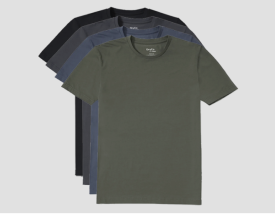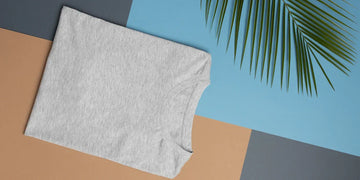A good undershirt should never be seen, felt, or thought about during your day. It’s meant to quietly keep you comfortable, dry, and looking sharp. But the wrong undershirt? It can ruin your whole outfit. We’re talking sweat marks, bunching, awkward lines, and that dreaded collar peek.
If you’ve ever found yourself sweating through a meeting or feeling uncomfortable halfway through the day, your undershirt could be the reason. Below are seven common undershirt mistakes and how to fix them with smarter choices like sweat proof undershirts and fits made to move with you.
1. Mistaking a T-Shirt for an Undershirt
T-shirts aren’t undershirts. They’re thicker, boxier, and weren’t built to layer. They ride up, add bulk, and make you overheat. Wearing one under a dress shirt feels like stacking bricks under silk.
Fix It: Grab a proper men’s undershirt. One that’s lightweight, fitted, and designed to disappear under layers. A good one hugs your frame without squeezing and stays tucked no matter how much you move. Bonus points if it’s a moisture wicking undershirt that keeps sweat at bay. Unlike tees, real undershirts offer sweat management, seamless layering, and sleek profiles that won’t disrupt the drape of your shirt.
2. Letting It Show
If your undershirt is peeking through your collar or sleeves, it’s not doing its job. Visible lines or bunching can throw off a clean, put-together look. This includes thick collars that show through button-downs, sleeve bunching under slim-fitting shirts, or hems that pop out of your waistband.
Fix It: Match the neckline to your outfit. Wearing your shirt unbuttoned? Go with a deep V-neck undershirt. Keeping it buttoned? A crew neck works. Look for flat seams, slim collars, and a cut that stays hidden. Tapered sleeves and tagless labels also help reduce friction and visibility.
3. Choosing the Wrong Color
White undershirt under a white shirt? That just draws more attention. Black undershirt under a light shirt? Even worse. Most guys don’t realize that the color contrast becomes even more noticeable under direct light.
Fix It: Go for a heather grey or a shade close to your skin tone. These colors blend in better and stay invisible beneath lighter dress shirts. If your skin tone is hard to match, heather grey is a safe universal option. It diffuses light instead of reflecting it, helping it disappear under white or pastel shirts.
4. Wearing Baggy or Short Undershirts
Loose undershirt bunch. Short ones untuck. Both leave you fidgeting all day. And when undershirts ride up, they can create friction around the midsection leading to irritation and chafing.
Fix It: Look for an undershirt that fits close to your body, with some stretch to move with you. The hem should be long enough to stay tucked even when you reach, bend, or twist. Tapered designs are especially great for slim builds, while longer cuts work better for taller men or anyone with a long torso. The goal is a second-skin feel that doesn’t restrict movement.
5. Choosing the Wrong Fabric
Thick cotton undershirts might feel soft at first, but they trap sweat and heat. That’s one of the reasons for discomfort. Some even hold onto odor after a wash, making them less than ideal for long days.
Fix It: Go for lightweight. Undershirts made from sweat-proof or moisture-wicking fabric will pull sweat away from your body and dry fast. Whether it’s bamboo, modal, or technical blends, your fabric choice should be thoughtful. Breathable mesh zones under arms or across the back are also great for extra airflow where you need it most.
6. Buying Cheap and Washing Carelessly
Low-quality undershirts lose shape, get see-through, and wear out fast. Toss in some hot water and dryer heat, and you’re left with a crumpled mess. The cheaper the shirt, the faster it breaks down, and you’ll end up spending more in the long run.
Fix It: Invest in premium men’s undershirts with reinforced stitching and durable blends. Wash with cold water. Skip the dryer. Hang dry to protect the fibers. A little care goes a long way. Avoid bleach and harsh detergents, which can degrade sweat-resistant coatings and stretch fibers. Bonus tip: store undershirts folded, not hung, to preserve their shape.
7. Wearing Your Undershirt as Outerwear
Undershirts worn solo? Not a great look unless you’re hitting the gym. And those classic A-shirts don’t offer much coverage where it counts. Even at home, a thin, fitted undershirt isn't the best choice for running errands or grabbing coffee.
Fix It: Keep undershirts under your shirts. If you want to go casual, wear an actual tee or a shirt made to be seen. Sweat proof undershirts are built for layering, not for center stage. Most lack the structural weight and finishing details like sleeve hems and outerwear stitching that make them stand up as solo pieces.
Frequently Asked Questions
Are sweat proof undershirts breathable, or do they trap heat?
Good ones are both sweat-proof and breathable. They’re designed to block sweat from reaching your outer shirt without suffocating your skin. Look for lightweight technical fabrics or multi-layer designs that keep air moving.
How often should I replace my undershirts?
With regular wear, high-quality undershirts should last 6 to 12 months. If they’re losing shape, turning yellow, or getting thin in high-friction zones, it’s time to refresh.
Can I wear a moisture wicking undershirt in winter?
Absolutely. Moisture wicking undershirts are great in colder seasons too. They pull moisture off your skin, preventing that cold, clammy feeling when you sweat under layers.
What's the best undershirt for people with hyperhidrosis?
A hyperhidrosis undershirt made with sweat-blocking panels and fast-drying fabric is ideal. Prioritize underarm protection, long coverage, and breathable zones.
Is it okay to layer a tight undershirt under a slim-fit dress shirt?
Yes, as long as the undershirt is smooth and fitted. Loose shirts bunch and show through. A well-fitted base layer improves how your outer shirt lays.
What’s the difference between compression undershirts and regular ones?
Compression undershirts offer muscle support and posture control. Standard undershirts focus on sweat control, layering, and comfort.
Should I size up for extra comfort?
Not for undershirts. You want a close-to-skin fit without compression. Sizing up can lead to bunching and visibility under clothes.
The Bottom Line
The right undershirt keeps you dry, confident, and distraction-free. When your base layer fits well and manages sweat, you stop thinking about discomfort and start focusing on what matters. A moisture wicking undershirt keeps you cool and composed during long meetings or stressful commutes, while a hyperhidrosis undershirt offers reliable protection for people who sweat more than usual. It prevents visible marks, reduces odors, and helps your dress shirts stay fresher for longer. The right one doesn’t just improve how you feel, it improves how you show up.
Choose smart. Stay dry. Look sharp. Shop Neat Appeal








